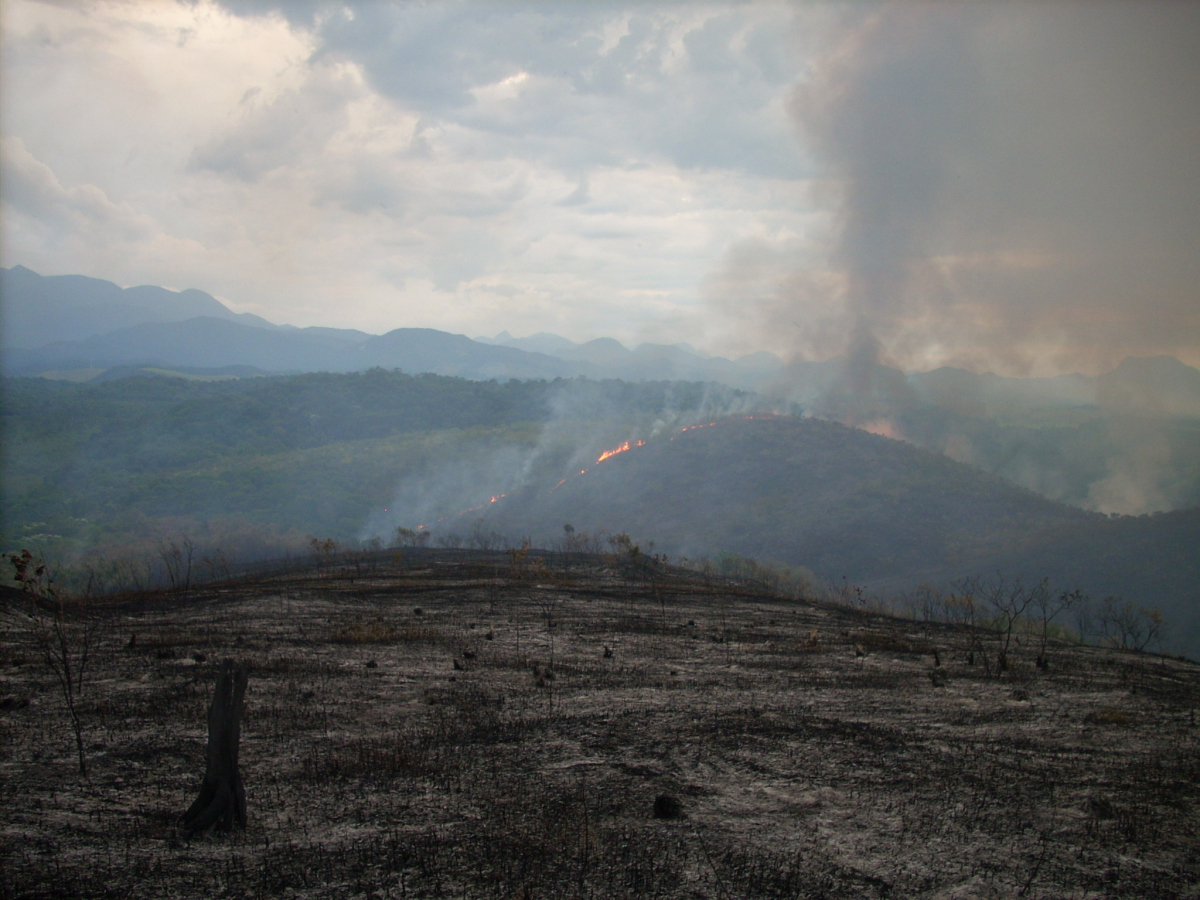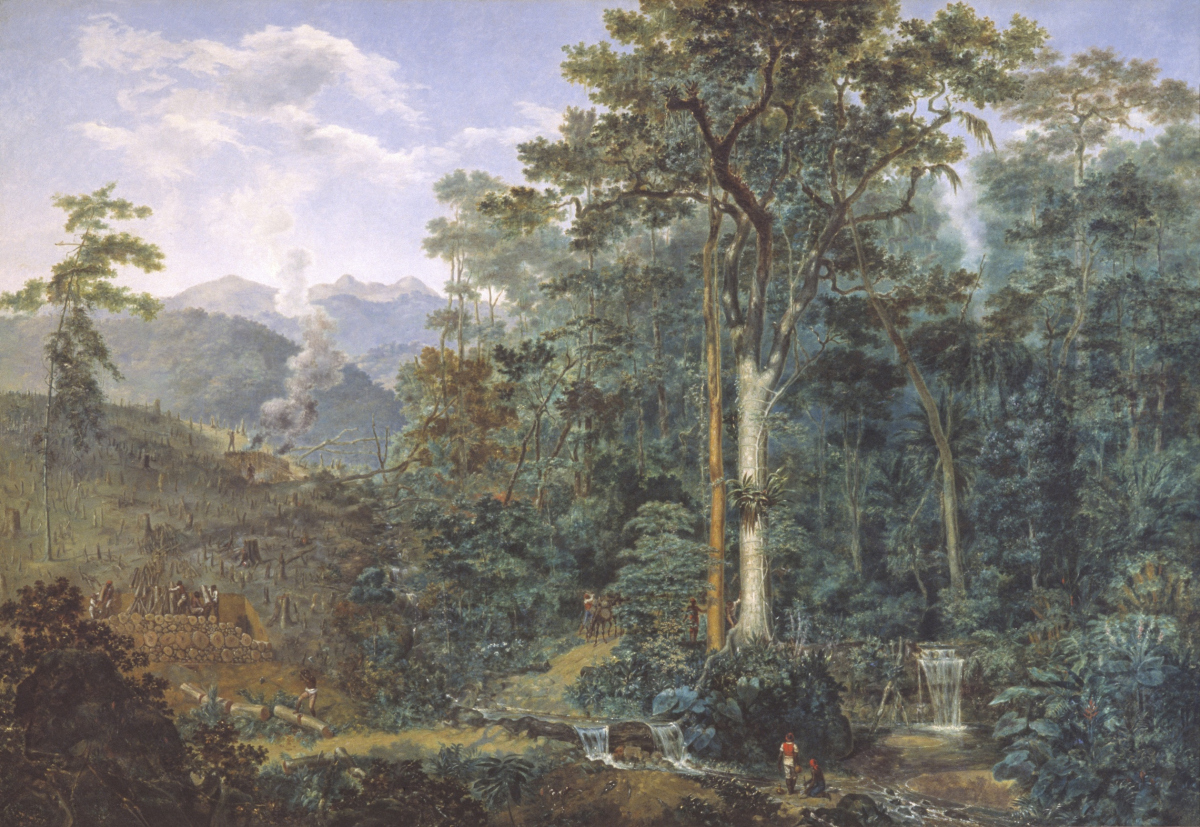Page path:
- Press Office
- Press releases 2012
- 13.08.2012 Marine Research and the Brazilian Ra...
13.08.2012 Marine Research and the Brazilian Rain Forest
Until recent decades the Atlantic Rainforest covered a large area of today’s Brazil from Amazonas to present-day Argentina. In the 1970s, after years of deforestation, this rain forest was almost completely destroyed, mainly replaced by cattle pastures. This study reveals an unexpected aspect of deforestation. Dr. Thorsten Dittmar´s team and colleagues from Brazil and the USA show that the common practice of slash and burn left huge amounts of charcoal in the soil. This charcoal is washed out by rainfalls and transported by rivers into the Atlantic Ocean. The soluble fraction of charcoal is composed of extremely stable carbon compounds. The authors conclude that the amounts of these compounds dissolved in the ocean will increase due to human civilization. So far, the effects on marine microorganisms and the global carbon cycle are unknown. The results are presented in the international scientific journal Nature Geoscience (DOI: 10.1038/ngeo1541).
Burning of the rain forest in the Atlantic National Park of Brazil. Source: Gustavo Luna Peixoto, ICMBio, Rio de Janeiro, Brazil.
Since way back mankind used fire to shape Earth´s vegetation. This was common practice in the 16th century when European settlers came to Brazil, and the beginning of the end of the rain forest. Slash and burn during the centuries reduced its size of 1.3 million to a mere 100,000 square kilometers. What was left was 200-500 millions tons of charred carbon in the soils. These remnants are complex and extremely stable carbon compounds. During the rainy seasons the water elutes the soluble fractions and transports the carbon to the Atlantic Ocean, affecting biogeochemical cycles for centuries and millenia.
In earlier times, the Atlantic rain forest covered a large track of today’s Brazil, reaching from 5 to 28 degree south latitude with an area of 1.3 million square kilometers. Until the midst of the 19th century about 95% was intact, but the growing demand for cattle pastures led to massive slash and burn practice which ceased in 1973 leaving only 15% of the original area unaffected. As of today only 8% (100,000 square kilometers) are left.
In earlier times, the Atlantic rain forest covered a large track of today’s Brazil, reaching from 5 to 28 degree south latitude with an area of 1.3 million square kilometers. Until the midst of the 19th century about 95% was intact, but the growing demand for cattle pastures led to massive slash and burn practice which ceased in 1973 leaving only 15% of the original area unaffected. As of today only 8% (100,000 square kilometers) are left.
It is the spirit of the destroyed rain forest which you can find in the rivers. Slash and burn: In the tropical forests big trunks are removed, the rest is burnt and huge amounts of charred coal is left in the soil. In 1843 the artist FÉLIX ÉMILE TAUNAY draw the attention to the destruction of the rain forest with his oil painting „View of a native forest that is being reduced to charcoal“.Oil on canvas, 143 x 195 cm. Source: Museu Nacional de Belas Artes/IBRAM/MinC. (registro n°832) Foto: Jaime Acioli. http://www.mnba.gov.br/
Marine research and the rain forest
Dr. Thorsten Dittmar and his group at the Max Planck Institute for Marine Microbiology analysed the samples in their laboratories at the University of Oldenburg which are an outpost station of the Bremen based Max Planck Institute. Their main research topic is the carbon cycle and the fate of the dissolved organic matter (DOM) in aquatic, mainly marine, systems. For the sample analysis of the present study they also used their ultrahigh resolution mass spectrometer.
Dr. Dittmar explains how they started their rain forest project:” A couple of years ago we detected telltale carbon compounds typical for burnt plant material and charcoal dissolved in ocean water. We speculated that the pre-harvest burning of sugar cane plantations and forest fires in Brazil was a major source. So, we as marine scientists, contacted our colleagues in Brazil, who had taken soil and water samples for years around the Paraiba do Sul river.”
The results were surprising. Substantially more carbon compounds where discharged by the river than the annual procedure of pre-harvest burning of sugar cane plantations could produce. “When we plotted the results from the samples against time and compared this pattern with the amount of precipitation and the occurrence of fires, the relation became obvious. The charred carbon must have originated from the slash and burn period from much earlier times.”
This assumption was confirmed by further experiments and data. The large scale slash and burn practice ended in 1973. The still practiced pre-harvest burning of the sugar cane plantations produces only 190-740 tons charred carbon annually, but the amount found in the river was three to sixteen times higher. The scientists extrapolated 50,000 to 70,000 tons for the annual load carried by rivers from the total area of the relict rain forest into the Atlantic Ocean. In the laboratory the soil of the rain forest gave the highest yield of carbon compounds in leaching experiments. More and more it became obvious that the sugar cane plantations were not the source, as also high concentrations of charred carbons were detected upstream of the river where only limited numbers of plantation were present.
Dr. Thorsten Dittmar and his group at the Max Planck Institute for Marine Microbiology analysed the samples in their laboratories at the University of Oldenburg which are an outpost station of the Bremen based Max Planck Institute. Their main research topic is the carbon cycle and the fate of the dissolved organic matter (DOM) in aquatic, mainly marine, systems. For the sample analysis of the present study they also used their ultrahigh resolution mass spectrometer.
Dr. Dittmar explains how they started their rain forest project:” A couple of years ago we detected telltale carbon compounds typical for burnt plant material and charcoal dissolved in ocean water. We speculated that the pre-harvest burning of sugar cane plantations and forest fires in Brazil was a major source. So, we as marine scientists, contacted our colleagues in Brazil, who had taken soil and water samples for years around the Paraiba do Sul river.”
The results were surprising. Substantially more carbon compounds where discharged by the river than the annual procedure of pre-harvest burning of sugar cane plantations could produce. “When we plotted the results from the samples against time and compared this pattern with the amount of precipitation and the occurrence of fires, the relation became obvious. The charred carbon must have originated from the slash and burn period from much earlier times.”
This assumption was confirmed by further experiments and data. The large scale slash and burn practice ended in 1973. The still practiced pre-harvest burning of the sugar cane plantations produces only 190-740 tons charred carbon annually, but the amount found in the river was three to sixteen times higher. The scientists extrapolated 50,000 to 70,000 tons for the annual load carried by rivers from the total area of the relict rain forest into the Atlantic Ocean. In the laboratory the soil of the rain forest gave the highest yield of carbon compounds in leaching experiments. More and more it became obvious that the sugar cane plantations were not the source, as also high concentrations of charred carbons were detected upstream of the river where only limited numbers of plantation were present.
Dr. Torsten Dittmar injecting a sample into the mass spectrometer. Source: Bastian Ehl, MPG.
Perspective
“There are current discussions in the scientific community about using charred carbon to sequester carbon and thereby removing it from the active global carbon cycle. Our data clearly show that this is not a sustainable procedure, as sooner or later this carbon ends up in the oceans and alters the ecosystem. And we do not know anything about the consequences”, Dr. Dittmar sums up his concerns. “The soluble fraction of charred carbon is extremely stable in the environment and withstands microbial activities. Therefore, we can trace it in the world´s oceans, even in remote places of the deep sea. Our study suggests that this stable fraction of charred carbon in the deep sea will increase due to the increase of anthropogenic activities. The consequences on the marine microorganisms and the global carbon cycle are unknown.”
Manfred Schloesser
For more information please contact
Dr. Thorsten Dittmar
Max-Planck-Forschungsgruppe Marine Geochemie
Institut für Chemie und Biologie des Meeres (ICBM)
Carl-von-Ossietzky-Strasse 9-11
D-26129 Oldenburg
Phone +49 441 798-3602
E-mail: [Bitte aktivieren Sie Javascript]
Dr. Jutta Niggemann
Max-Planck-Forschungsgruppe Marine Geochemie
Institut für Chemie und Biologie des Meeres (ICBM)
Carl-von-Ossietzky-Strasse 9-11
D-26129 Oldenburg
Tel.: +49 441 798-3365
E-mail: [Bitte aktivieren Sie Javascript]
or contact the press officers of the Max Planck Institute for Marine Microbiology
Dr. Manfred Schloesser, +49 421 2028704, [Bitte aktivieren Sie Javascript]
Dr. Rita Dunker, +49 421 2028856, [Bitte aktivieren Sie Javascript]
Original article
Continuous flux of dissolved black carbon from a vanished tropical forest biome.
Thorsten Dittmar, Carlos Eduardo de Rezende, Marcus Manecki, Jutta Niggemann, Alvaro Ramon Coelho Ovalle, Aron Stubbins and Marcelo Correa Bernardes. Nature Geoscience, 2012. Advanced Online Publication.
DOI: 10.1038/ngeo1541
“There are current discussions in the scientific community about using charred carbon to sequester carbon and thereby removing it from the active global carbon cycle. Our data clearly show that this is not a sustainable procedure, as sooner or later this carbon ends up in the oceans and alters the ecosystem. And we do not know anything about the consequences”, Dr. Dittmar sums up his concerns. “The soluble fraction of charred carbon is extremely stable in the environment and withstands microbial activities. Therefore, we can trace it in the world´s oceans, even in remote places of the deep sea. Our study suggests that this stable fraction of charred carbon in the deep sea will increase due to the increase of anthropogenic activities. The consequences on the marine microorganisms and the global carbon cycle are unknown.”
Manfred Schloesser
For more information please contact
Dr. Thorsten Dittmar
Max-Planck-Forschungsgruppe Marine Geochemie
Institut für Chemie und Biologie des Meeres (ICBM)
Carl-von-Ossietzky-Strasse 9-11
D-26129 Oldenburg
Phone +49 441 798-3602
E-mail: [Bitte aktivieren Sie Javascript]
Dr. Jutta Niggemann
Max-Planck-Forschungsgruppe Marine Geochemie
Institut für Chemie und Biologie des Meeres (ICBM)
Carl-von-Ossietzky-Strasse 9-11
D-26129 Oldenburg
Tel.: +49 441 798-3365
E-mail: [Bitte aktivieren Sie Javascript]
or contact the press officers of the Max Planck Institute for Marine Microbiology
Dr. Manfred Schloesser, +49 421 2028704, [Bitte aktivieren Sie Javascript]
Dr. Rita Dunker, +49 421 2028856, [Bitte aktivieren Sie Javascript]
Original article
Continuous flux of dissolved black carbon from a vanished tropical forest biome.
Thorsten Dittmar, Carlos Eduardo de Rezende, Marcus Manecki, Jutta Niggemann, Alvaro Ramon Coelho Ovalle, Aron Stubbins and Marcelo Correa Bernardes. Nature Geoscience, 2012. Advanced Online Publication.
DOI: 10.1038/ngeo1541



